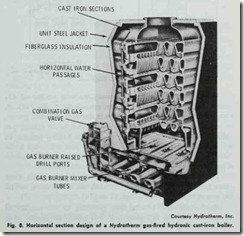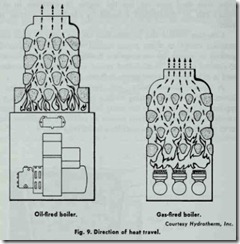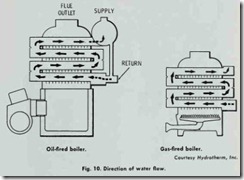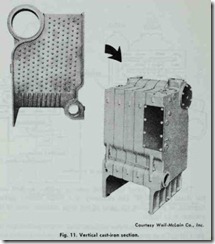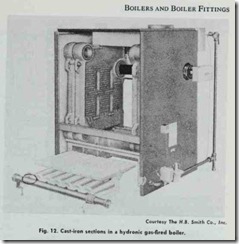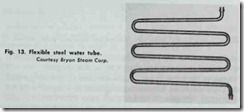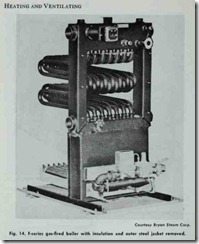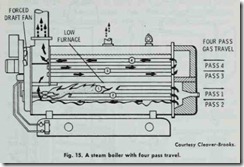BOILER HEATING SURFACE
The boiler heating surface (expressed in square feet) is that portion of the surface of the heat transfer apparatus in contact with the fluid being heated on one side and the gas or refractory being cooled on the other side. The direct or radiant heating sur face is the surface against which the fire strikes. The surface which comes in contact with the hot gases is called the indirect or con vection surface.
The heating capacity of any boiler is influenced by the amount and arrangement of the heating surface, and the temperatures on either side. The arrangement of the heating surface refers to the ratio of the diameter of each passage to its length, also its contour (straight or curved), cross sectional shape, number of passes, and other design variables.
BOILER EFFICIENCY
The boiler efficiency is the ratio of the heat output to the calo rific value of the fuel. Boiler efficiency is determined by a number of different factors, including the type of fuel used, the method of firing, and the control settings. For example, oil- and gas-fired boilers have boiler efficiencies ranging from 70 to 80 percent. On the other hand, a hand fired boiler in which anthracite coal is used will have a boiler efficiency of 60 to 75 percent.
TYPES OF BOILERS
The boilers used in low-pressure steam and hot-water space heating systems can be classified in a number of different ways. Some of the criteria used in classifying them will include:
1. Construction material,
2. Construction design,
3. Boiler position,
4. Number of passes of the hot gases,
5. Length of travel of the hot gases,
6. Type of heating surface,
7. Type of fuel used.
Most boilers are either cast iron or steel construction. Veryfew are constructed from nonferrous materials. Cast-iron boilers generally display a greater resistance to the corrosive effects of water than steel ones do, but the degree of corrosion in steel boilers can be significantly reduced by chemically treating the water.
Cast-iron boilers can be classified on the basis of their construction design as either round boilers with horizontal pancake sections or square (or rectangular) boilers with either horizontal or vertical sections. A coal-fired round vertical boiler commonly used in older heating installations is shown in Fig. 7. A square shaped boiler with horizontal section design is shown in Fig. 8. The heating surface of each cast-iron section is exposed at right angles to the rising flue gases (Fig. 9). The water travels in a zig-zag path from section to section in a manner simi lar to the flow of water in a steel tube boiler (Fig. 10).
Vertical cast-iron sections are available in a number of dif ferent designs, depending upon the manufacturer (Fig. 11). A typical arrangement of these sections is shown in Fig. 12.
Steel boilers may be classified with respect to the relative po sition of water and hot gases in the tubular heating surface. In fire-tube boilers, for example, the hot gases pass within the boiler tubes and the water necessary to produce the steam circulates around them. In water-tube boilers, the reverse is true.
Flexible steel tubes are used in Bryan steam and hot-water space heating boilers for the rapid circulation of the water around the heat rising from the fire (Figs. 13 and 14).
Boilers can also be classified according to the number of passes made by the hot gases (e.g. one pass, two passes, three passes, etc.) (Fig. 15.).
The length of travel of the hot gases is another method used for classifying boilers. The efficiency of a boiler heating surface depends, in part, upon the ratio of the cross sectional area of the passage to its length.
Among the various types of fuels used to fire boilers are oil, gas (natural and propane), coal and coke. Conversion kits for con verting a boiler from one gas to another are available from some manufacturers. Changing from coal (or coke) to oil or gas can be accomplished by using conversion chambers and making certain of other modifications (see Chapter 16. BOILER AND FURNACE CONVERSIONS).
Electricity can also be used to fire boilers. One advantage in using electric-fired boilers is that the draft provisions required by boilers using combustible fuels is not necessary.
The classificatory criteria described above were selective and limited to the more common types in use. Considering the multi plicity of boiler types and designs available, it is extremely diffi cult to establish a classification system suitable for all of them.
Gas-Fired Boilers
Gas-fired steam and hot-water space heating boilers generally consist of a number of closely placed cast iron sections or steel tubes with a series of gas burners (i.e. a gas burner assembly) placed beneath them. The flue gases pass upwards between the sections or tubes to the flue collector.
Draft losses are kept low in these boilers, because the pressure at which the gas is supplied is generally sufficient to draw in the amount of air necessary for combustion. The fact that there is no fuel bed resistance , as is the case with coal-fired boilers, also contributes to low draft loss.
The draft in gas-fired boilers is generally nullified by the di verter; consequently, the resistance offered by the boiler passages is not an important variable. When there is a problem of excessive draft, it can be controlled by installing a sheet metal baffle in the flue connection at the boiler (see CONTROL OF EXCESSIVE DRAFT ON GAS-FIRED BOILERS in this chapter).
Most of the controls and accessories used to operate gas-fired boilers are described in considerable detail in Chapter 2 (GAS BURNERS), Chapter 5 (GAS AND OIL CONTROLS), and Chapter 6 of Volume 2 (OTHER AUTOMATIC CONTROLS). The exact placement of these controls and accessories on the steel boiler jacket may differ slightly from one manufacturer to another, but no significantly. The I?J.ajor difference will be in the types of con trols and accessories used to govern the temperature, pressure, and flow rate of the heat conveying medium; and this is determined by whether it is a steam or hot-water space heating boiler (see STEAM BOILER FITTINGS AND ACCESSORIES and HOT WATER BOILER FITTINGS AND ACCESSORIES in this chapter). An exploded view of a Hydrotherm gas-fired boiler illustrating the location of various controls and accessories is shown in Fig. 16.

